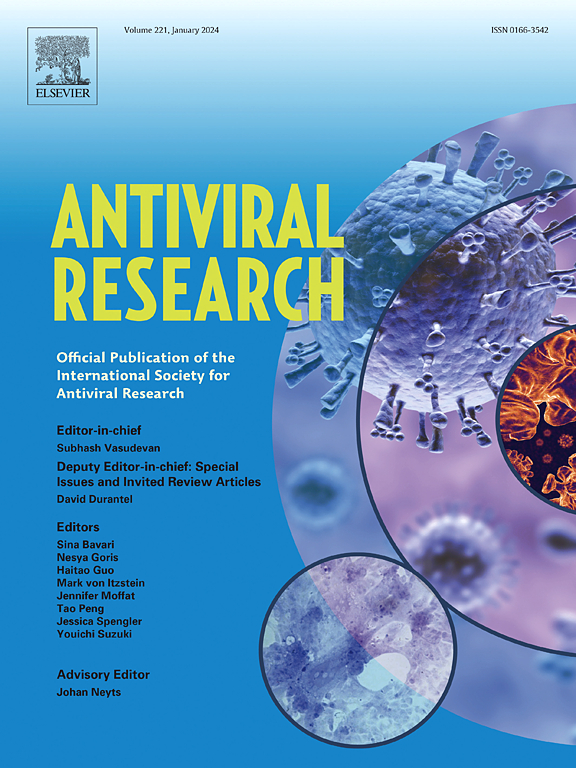sirna处理的hbv复制细胞和小鼠模型中残留病毒的表达
IF 4.5
2区 医学
Q1 PHARMACOLOGY & PHARMACY
引用次数: 0
摘要
小干扰RNA (siRNA)可有效降低乙型肝炎病毒(HBV)抗原,但最近的临床试验结果表明其有效性和持久性尚不令人满意,需要进一步的机制研究。本研究旨在通过体外和体内模型探索siRNA处理后残留病毒核酸的表达模式和潜在来源,增强对siRNA抗病毒作用的认识。采用生化方法,结合免疫荧光和荧光原位杂交技术,在HBV感染的HepG2-NTCP细胞模型和rAAV8-HBV1.3小鼠模型中,在单细胞水平上分析靶向HBV S、X、C编码区的sirna的抗病毒作用。结果表明,在体外和体内模型中,单剂量siRNA处理并没有显著降低任何HBV标记物阳性细胞的比例。残留的病毒抗原和核酸信号在单个细胞中广泛分布。siRNA的抗病毒作用通常表现为对HBV的剂量依赖性抑制,但在不同的病毒标记物上有所不同,可能是由于靶区、结合和细胞内病毒表达模式等因素,对核心颗粒DNA有潜在的抑制平台。此外,siRNA与HBV核心抑制剂GLS4的联合进一步降低了人原代肝细胞内的细胞内病毒DNA。这些发现来自结合原位检测技术的实验模型,揭示了siRNA处理下残留HBV抗原和核酸的表达模式,加深了对其抗病毒作用的理解,但临床复杂性需要进一步研究。本文章由计算机程序翻译,如有差异,请以英文原文为准。
Residual viral expression in siRNA-treated HBV-replicating cell and mouse models
Small interfering RNA (siRNA) effectively reduces hepatitis B virus (HBV) antigens, but recent clinical trial results indicate that its efficacy and durability remain unsatisfied, warranting further mechanistic investigation. This study aims to explore the expression patterns and potential sources of residual viral nucleic acids following siRNA treatment in both in vitro and in vivo models, enhancing the understanding of siRNA's antiviral effects. Biochemical methods, combined with immunofluorescence and fluorescent in situ hybridization techniques, were employed to analyze the antiviral effects of siRNAs targeting the S, X, and C coding regions of HBV at the single-cell level in HBV-infected HepG2-NTCP cell model and rAAV8-HBV1.3 mouse model. The results indicate that, in both the in vitro and in vivo models, a single dose of siRNA treatment did not significantly reduce the proportion of cells positive for any HBV marker. Residual viral antigen and nucleic acid signals were broadly distributed across individual cells. The antiviral effects of siRNA generally exhibit dose-dependent inhibition of HBV, but vary across different viral markers, potentially due to factors such as target region, engagement, and the viral expression patterns within cells, with a potential inhibition plateau for core particle DNA. Furthermore, the combination of siRNA and the HBV core inhibitor GLS4 further reduced intracellular viral DNA in primary human hepatocytes. These findings obtained from experimental models incorporating in situ detection techniques reveal the expression patterns of residual HBV antigens and nucleic acids under siRNA treatment, deepening the understanding of its antiviral effects, while clinical complexities require further investigation.
求助全文
通过发布文献求助,成功后即可免费获取论文全文。
去求助
来源期刊

Antiviral research
医学-病毒学
CiteScore
17.10
自引率
3.90%
发文量
157
审稿时长
34 days
期刊介绍:
Antiviral Research is a journal that focuses on various aspects of controlling viral infections in both humans and animals. It is a platform for publishing research reports, short communications, review articles, and commentaries. The journal covers a wide range of topics including antiviral drugs, antibodies, and host-response modifiers. These topics encompass their synthesis, in vitro and in vivo testing, as well as mechanisms of action. Additionally, the journal also publishes studies on the development of new or improved vaccines against viral infections in humans. It delves into assessing the safety of drugs and vaccines, tracking the evolution of drug or vaccine-resistant viruses, and developing effective countermeasures. Another area of interest includes the identification and validation of new drug targets. The journal further explores laboratory animal models of viral diseases, investigates the pathogenesis of viral diseases, and examines the mechanisms by which viruses avoid host immune responses.
 求助内容:
求助内容: 应助结果提醒方式:
应助结果提醒方式:


